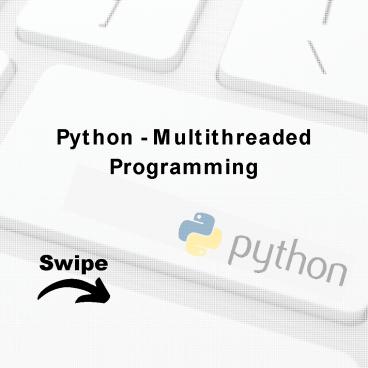Python - Multithreaded Programming PowerPoint PPT Presentation
Title: Python - Multithreaded Programming
1
Python - Multithreaded Programming
Swipe
2
Python - Multithreaded Programming
Running several threads is similar to running
several different programs concurrently, but with
the following benefits Multiple threads within
a process share the same data space with the
main thread and can therefore share information
or communicate with each other more easily than
if they were separate processes. Threads
sometimes called light-weight processes and they
do not require much memory overhead they are
cheaper than processes.
3
A thread has a beginning, an execution sequence,
and a conclusion. It has an instruction pointer
that keeps track of where within its context it
is currently running. It can be pre-empted
(interrupted) It can temporarily be put on hold
(also known as sleeping) while other threads are
running - this is called yielding.
4
Starting a New Thread
To spawn another thread, you need to call
following method available in thread module
thread.start_new_thread ( function, args,
kwargs ) This method call enables a fast and
efficient way to create new threads in both
Linux and Windows. The method call returns
immediately and the child thread starts and
calls function with the passed list of
args. When function returns, the thread
terminates.
5
The Threading Module
The newer threading module included with Python
2.4 provides much more powerful, high- level
support for threads than the thread module
discussed in the previous section. The threading
module exposes all the methods of the thread
module and provides some additional
methods threading.activeCount() - Returns the
number of thread objects that are active.
threading.currentThread() - Returns the number of
thread objects in the caller's thread
control. threading.enumerate() - Returns a list
of all thread objects that are currently active.
6
In addition to the methods, the threading module
has the Thread class that implements
threading. The methods provided by the Thread
class are as follows run() - The run() method
is the entry point for a thread. start() - The
start() method starts a thread by calling the
run method. join(time) - The join() waits for
threads to terminate. isAlive() - The isAlive()
method checks whether a thread is still
executing. getName() - The getName() method
returns the name of a thread. setName() - The
setName() method sets the name of a thread.
7
Creating Thread Using Threading Module
To implement a new thread using the threading
module, you have to do the following Define a
new subclass of the Thread class. Override the
init (self ,args) method to add additional
arguments. Then, override the run(self ,args)
method to implement what the thread should do
when started. Once you have created the new
Thread subclass, you can create an instance of
it and then start a new thread by invoking the
start(), which in turn calls run() method.
8
Synchronizing Threads
The threading module provided with Python
includes a simple-to-implement locking mechanism
that allows you to synchronize threads. A new
lock is created by calling the Lock() method,
which returns the new lock. The
acquire(blocking) method of the new lock object
is used to force threads to run
synchronously. The optional blocking parameter
enables you to control whether the thread waits
to acquire the lock.
9
If blocking is set to 0, the thread
returns immediately with a 0 value if the lock
cannot be acquired and with a 1 if the lock was
acquired. If blocking is set to 1, the thread
blocks and wait for the lock to be released.
10
Multithreaded Priority Queue
- The Queue module allows you to create a new
queue object that can hold a specific number of - items. There are following methods to control the
Queue. - get() - The get() removes and returns an item
from the queue. - put() - The put adds item to a queue. qsize() -
The qsize() returns the number of items that are
currently in the queue. - empty() - The empty( ) returns True if queue is
empty otherwise, False. - full() - the full() returns True if queue is
full otherwise, False.
11
Topics for next Post
Python - GUI Programming (Tkinter) Statistic
Probability Stay Tuned with

